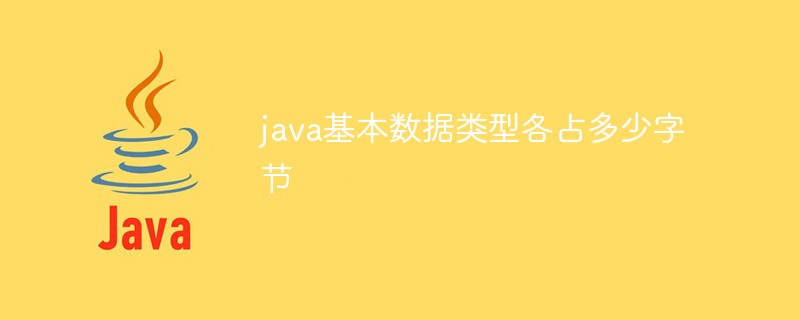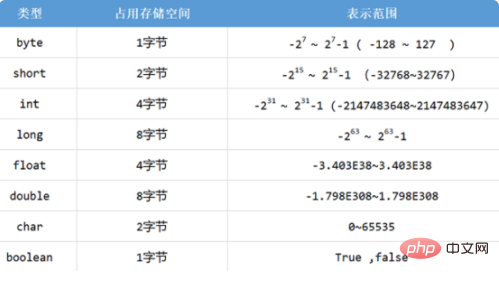How many bytes do each of Java's basic data types occupy?
Sep 12, 2020 am 11:14 AMJava's basic data types each occupy 1 byte: 1. Integer byte occupies 1 byte, short occupies 2 bytes; 2. Float occupies 4 bytes, and double occupies 8 bytes. Bytes; 3. Char type occupies 2 bytes.

Related learning recommendations: java basic tutorial
There are a total of 8 types in Java Basic data types, including 4 integer types, 2 floating point types, 1 character type used to represent Unicode-encoded character units, and 1 boolean type used to represent true values.
One byte is equal to 8 bits, and Java is platform-independent.
(1) Integer type:
Among them, byte, short, int, and long all represent integers, but their value ranges are different
The value range of byte is -128~127, occupying 1 byte (-2 to the 7th power to 2 to the 7th power -1)
-
The value range of short is -32768~32767, occupying 2 bytes (-2 to the 15th power of 2 -1)
The value of int The value range is (-2147483648~2147483647), occupying 4 bytes (-2 to the 31st power of 2 -1)
The value range of long is ( -9223372036854774808~9223372036854774807), occupying 8 bytes (-2 to the 63rd power of 2 -1).
You can see that the value range of byte and short is relatively small, while the value range of long is too large and takes up a lot of space. Basically int can meet our daily calculations. , and int is also the most commonly used integer type.
Under normal circumstances, if an integer number such as 35 appears in JAVA, then this number is of int type. If we want it to be of byte type, we can add a capital B after the data: 35B , indicating that it is of byte type.
Similarly, 35S represents short type, and 35L represents long type. If it represents int, we can add nothing, but if we want to represent long type, we must add "L" after the data.
(2) Floating point type:
float and double are data types representing floating point types. The difference between them is that they The accuracy of second power) occupies 4 bytes
double 1.797693e 308~ 4.9000000e-324 occupies 8 bytes
double type is better than float type has a larger storage range and higher precision, so usually floating-point data is of double type without declaration. If you want to indicate that a data is of float type, you can add "F" after the data.
Floating point data is not completely accurate, so sometimes the last few decimal places may float during calculation. This is normal.
This type has only two values, true and false (true and not true)
boolean t = true;
boolean f = false;
- (4) char type (text Type):
The data type used to store characters, occupies 2 bytes, uses unicode encoding, and its first 128 bytes of encoding are compatible with ASCII The storage range of characters In \u0000~\uFFFF, pay attention to adding ' ' when defining character data. For example, '1' means the character '1' instead of the value 1,
char c = ' 1 ';
Let’s try to output c. System.out.println(c); The result is 1, but if we output it like this System.out.println(c 0);
The result becomes 49.
Extended information
Conversion between basic typesAssign a value of one type to another One type is very common. In Java, it is clear that the boolean type cannot be converted to the other 7 types of data.
But for the other 7 data types, they can be converted between them, but there may be a loss of precision or some other changes.
Conversion is divided into automatic conversion and forced conversion:
Automatic conversion (implicit): no operation required.
Forced conversion (explicit): You need to use the conversion operator (type).
-
Arrange the six data types in the following order:
double > float > long > int > short > byte
If you convert from small to large, you can convert directly, and from large to small, or char and For other 6 data type conversions, you must use forced conversion.
php training
column!The above is the detailed content of How many bytes do each of Java's basic data types occupy?. For more information, please follow other related articles on the PHP Chinese website!

Hot AI Tools

Undress AI Tool
Undress images for free

Undresser.AI Undress
AI-powered app for creating realistic nude photos

AI Clothes Remover
Online AI tool for removing clothes from photos.

Clothoff.io
AI clothes remover

Video Face Swap
Swap faces in any video effortlessly with our completely free AI face swap tool!

Hot Article

Hot Tools

Notepad++7.3.1
Easy-to-use and free code editor

SublimeText3 Chinese version
Chinese version, very easy to use

Zend Studio 13.0.1
Powerful PHP integrated development environment

Dreamweaver CS6
Visual web development tools

SublimeText3 Mac version
God-level code editing software (SublimeText3)

Hot Topics
 Tips for Writing PHP Comments
Jul 18, 2025 am 04:51 AM
Tips for Writing PHP Comments
Jul 18, 2025 am 04:51 AM
The key to writing PHP comments is to clarify the purpose and specifications. Comments should explain "why" rather than "what was done", avoiding redundancy or too simplicity. 1. Use a unified format, such as docblock (/*/) for class and method descriptions to improve readability and tool compatibility; 2. Emphasize the reasons behind the logic, such as why JS jumps need to be output manually; 3. Add an overview description before complex code, describe the process in steps, and help understand the overall idea; 4. Use TODO and FIXME rationally to mark to-do items and problems to facilitate subsequent tracking and collaboration. Good annotations can reduce communication costs and improve code maintenance efficiency.
 Writing Effective PHP Comments
Jul 18, 2025 am 04:44 AM
Writing Effective PHP Comments
Jul 18, 2025 am 04:44 AM
Comments cannot be careless because they want to explain the reasons for the existence of the code rather than the functions, such as compatibility with old interfaces or third-party restrictions, otherwise people who read the code can only rely on guessing. The areas that must be commented include complex conditional judgments, special error handling logic, and temporary bypass restrictions. A more practical way to write comments is to select single-line comments or block comments based on the scene. Use document block comments to explain parameters and return values at the beginning of functions, classes, and files, and keep comments updated. For complex logic, you can add a line to the previous one to summarize the overall intention. At the same time, do not use comments to seal code, but use version control tools.
 Improving Readability with Comments
Jul 18, 2025 am 04:46 AM
Improving Readability with Comments
Jul 18, 2025 am 04:46 AM
The key to writing good comments is to explain "why" rather than just "what was done" to improve the readability of the code. 1. Comments should explain logical reasons, such as considerations behind value selection or processing; 2. Use paragraph annotations for complex logic to summarize the overall idea of functions or algorithms; 3. Regularly maintain comments to ensure consistency with the code, avoid misleading, and delete outdated content if necessary; 4. Synchronously check comments when reviewing the code, and record public logic through documents to reduce the burden of code comments.
 Effective PHP Commenting
Jul 18, 2025 am 04:33 AM
Effective PHP Commenting
Jul 18, 2025 am 04:33 AM
The key to writing PHP comments is clear, useful and concise. 1. Comments should explain the intention behind the code rather than just describing the code itself, such as explaining the logical purpose of complex conditional judgments; 2. Add comments to key scenarios such as magic values, old code compatibility, API interfaces, etc. to improve readability; 3. Avoid duplicate code content, keep it concise and specific, and use standard formats such as PHPDoc; 4. Comments should be updated synchronously with the code to ensure accuracy. Good comments should be thought from the perspective of others, reduce the cost of understanding, and become a code understanding navigation device.
 Understanding PHP Variables
Jul 17, 2025 am 04:11 AM
Understanding PHP Variables
Jul 17, 2025 am 04:11 AM
PHP variables start with $, and the naming must follow rules, such as they cannot start with numbers and are case sensitive; the scope of the variable is divided into local, global and hyperglobal; global variables can be accessed using global, but it is recommended to pass them with parameters; mutable variables and reference assignments should be used with caution. Variables are the basis for storing data, and correctly mastering their rules and mechanisms is crucial to development.
 PHP Development Environment Setup
Jul 18, 2025 am 04:55 AM
PHP Development Environment Setup
Jul 18, 2025 am 04:55 AM
The first step is to select the integrated environment package XAMPP or MAMP to build a local server; the second step is to select the appropriate PHP version according to the project needs and configure multiple version switching; the third step is to select VSCode or PhpStorm as the editor and debug with Xdebug; in addition, you need to install Composer, PHP_CodeSniffer, PHPUnit and other tools to assist in development.
 Understanding PHP Variable Types
Jul 17, 2025 am 04:12 AM
Understanding PHP Variable Types
Jul 17, 2025 am 04:12 AM
PHP has 8 variable types, commonly used include Integer, Float, String, Boolean, Array, Object, NULL and Resource. To view variable types, use the gettype() or is_type() series functions. PHP will automatically convert types, but it is recommended to use === to strictly compare the key logic. Manual conversion can be used for syntax such as (int), (string), etc., but be careful that information may be lost.
 PHP Commenting Syntax
Jul 18, 2025 am 04:56 AM
PHP Commenting Syntax
Jul 18, 2025 am 04:56 AM
There are three common ways to use PHP comments: single-line comments are suitable for briefly explaining code logic, such as // or # for the explanation of the current line; multi-line comments /*...*/ are suitable for detailed description of the functions or classes; document comments DocBlock start with /** to provide prompt information for the IDE. When using it, you should avoid nonsense, keep updating synchronously, and do not use comments to block codes for a long time.






